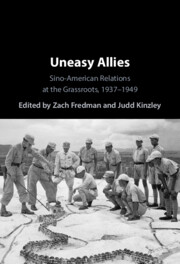Book contents
- Uneasy Allies
- Uneasy Allies
- Copyright page
- Contents
- Figures
- Contributors
- Acknowledgments
- Maps
- 1 Introduction
- Part I An Informal Alliance
- Part II Entanglements of American Empire
- Part III American Power and the New World Order
- 7 American Peace Movements and the Legacies of Transpacific Wartime Activism
- 8 The China Institute in America and the Politics of China’s Cultural Diplomacy
- 9 Sino-American Wartime Material Exchange and the Economic Foundations of the Cold War Order
- Part IV The New Imperialism
- Bibliography
- Index
7 - American Peace Movements and the Legacies of Transpacific Wartime Activism
from Part III - American Power and the New World Order
Published online by Cambridge University Press: 12 December 2024
- Uneasy Allies
- Uneasy Allies
- Copyright page
- Contents
- Figures
- Contributors
- Acknowledgments
- Maps
- 1 Introduction
- Part I An Informal Alliance
- Part II Entanglements of American Empire
- Part III American Power and the New World Order
- 7 American Peace Movements and the Legacies of Transpacific Wartime Activism
- 8 The China Institute in America and the Politics of China’s Cultural Diplomacy
- 9 Sino-American Wartime Material Exchange and the Economic Foundations of the Cold War Order
- Part IV The New Imperialism
- Bibliography
- Index
Summary
This chapter examines how the China Institute in America, a New York-based cultural organization that promoted public understandings of China since its founding in 1926, weathered unprecedented financial challenges in the 1940s and 1950s. Much more than a single cultural organization’s bottom line, the China Institute’s trans-Pacific fundraising with different American philanthropists and the Chinese Nationalist government was an understudied bellwether of the shifting political and philanthropic foundations of public discussions of China in the mid-twentieth century United States. Given existing evidence, these efforts were more about the Institute’s survival and its adaptation to increasingly politicized philanthropy than any inherent ideological orientation. A nodal point, active participant, strategic beneficiary, and collateral damage in this philanthropic Cold War, the China Institute amplifies the uneasy engagement between China and the United States in the mid-twentieth century. Following the money allows historians to make better sense of the China Institute’s political posturing in a tumultuous period rather than simply take its public rhetoric at face value.
Keywords
- Type
- Chapter
- Information
- Uneasy AlliesSino-American Relations at the Grassroots, 1937–1949, pp. 115 - 135Publisher: Cambridge University PressPrint publication year: 2024

